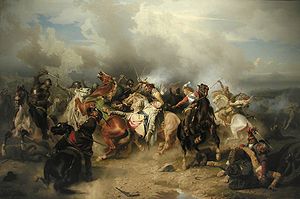Battle of Buxar
Battle of Buxar ==== Military conflict ====
| Battle of Lützen | |||||||
|---|---|---|---|---|---|---|---|
| Part of the Thirty Years' War | |||||||
 The Battle of Lützen by Carl Wahlbom shows the death of King Gustavus Adolphus on November 16, 1632. | |||||||
| |||||||
| Belligerents | |||||||
|
Sweden, Protestant German states |
Holy Roman Empire, Catholic German states | ||||||
| Commanders and leaders | |||||||
|
Gustavus Adolphus†, Bernhard of Saxe-Weimar |
Albrecht von Wallenstein, Gottfried zu Pappenheim† | ||||||
| Strength | |||||||
|
12,800 infantry, 6,200 cavalry, 60 guns |
10,000 infantry, 7,000 cavalry, 24 guns | ||||||
| Casualties and losses | |||||||
|
3,400 dead, 1,600 wounded or missing | 3,000–3,500 dead or wounded | ||||||
A(October 1764) was a significant battle fought between the forces under the command of the British East India Company on the one side, and the combined armies of Mir Kasim, the Nawab of Bengal ; Nawab of Awadh; and Shah Alam II, the Mughal Emperor. The battle fought at Buxar, a town (currently in Bihar state, India) located on the bank of the Ganges river, was a decisive battle won by the forces of the East India Company.
The battle resulted into securing of Diwani rights to administer the collection and management of revenues of large areas which currently form parts of Indian states of West Bengal, Bihar, Jharkhand, and Uttar Pradesh , as well as of Bangladesh. The Battle of Buxar heralded the establishment of the rule of the East India Company in the eastern part of the Indian subcontinent.
